Exploring the intersection of spaceflight history, pop culture, and space art.
Creating Space begins its third year of publication with a 3-D look at the quarter scale model of the 1963-1964 Apollo Lunar Excursion Module design that I shared last time. Along the way, we will visit a simulated lunar landscape that existed for a time at the Manned Spacecraft Center in Houston, Texas.
Are you new to Creating Space? It’s the NERDSletter that explores the intersection of spaceflight history, pop culture, and space art. You can find this and all other posts at creating-space.art.
Models of the Quarter
In the past two editions of Creating Space, regular readers have been treated to two increasingly large models of one of the developmental versions of the Apollo Lunar Excursion Module (LEM). Here they are, again, as a refresher. If you are a new reader of this NERDSletter, please be sure to click through to the previous articles.
The first LEM model was approximately 1:12 scale and stood 22 inches (56 cm) tall. Its span dimension, measured diagonally across opposing footpads, was 32 inches (81 cm). Here’s NASA scientist, Julian Rogers, on the left holding an example of the model with L. J. Carter of the British Interplanetary Society in 1966.
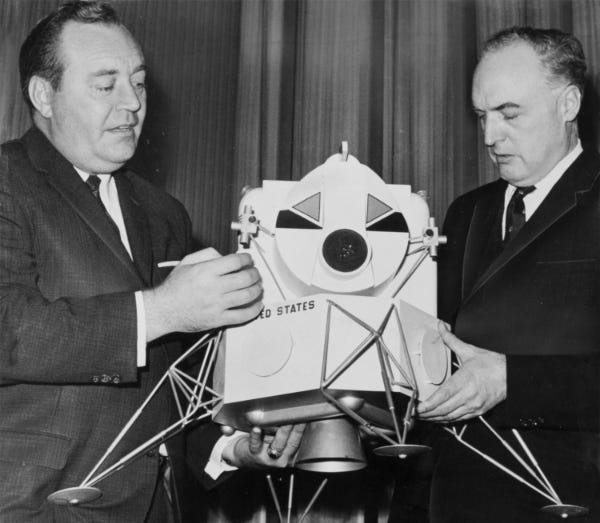
The second model was a quarter scale version of the same configuration. It stood over 5 feet (1.5 m) tall. These women are provisional members of the Junior League of Seattle and are giving their full attention to the large LEM model for the benefit of the photographer. The photo was taken at the Pacific Science Center in 1968.
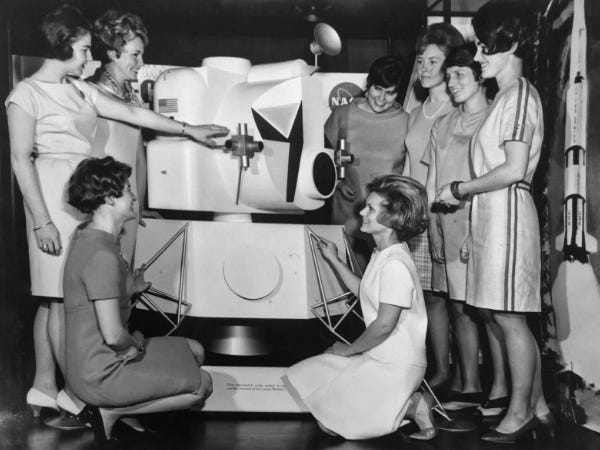
Now, we will again take a look at the larger of the two models, this time using it to explore the dimension of depth by venturing deep into the world of lenticular images.
Don’t worry if you’ve misplaced your 3-D glasses because where we’re going we won’t need them.
LEM on the Rocks
To set the stage for this story, we need to look back at one of the ways NASA devised to prepare its Apollo astronauts for what they might encounter after they landed on the Moon, and to test some of the equipment they would use. I’ve previously talked about rocket gardens – now, you’ll learn a little bit about NASA’s rock garden.
Around the middle of the decade that began in 1960, lunar mission planners at the Manned Spacecraft Center in Houston, Texas (later to be named after President Lyndon B. Johnson), constructed a lunar activities training field in a large parcel of land some distance to the northwest of the main facilities. Within the fenced off area, part of the former cattle grazing area upon which the center was built, they bulldozed a reasonable facsimile of the lunar landscape, complete with a couple sizable craters. Covering the gently sloping moonscape were rugged gray rocks and boulders. The surface features were likely based upon imagery obtained from the unmanned Ranger probes launched earlier. The name given to this terrestrially-based training area was what one might expect from NASA – the Lunar Topographical Simulation Area.
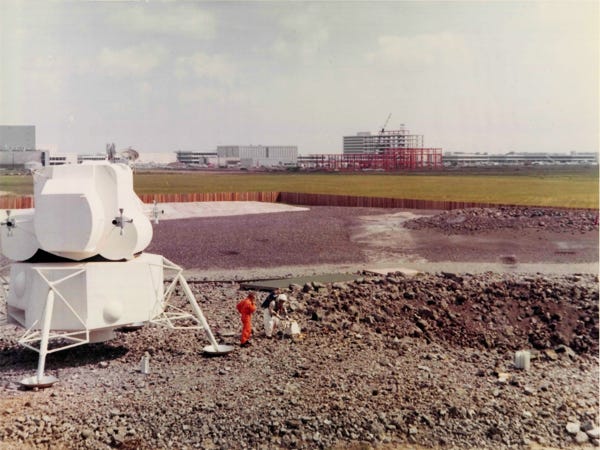
For those who may be familiar with the layout of the Johnson Space Center, or who may want to go on a space history archeological expedition1, here are some photos that show where the Lunar Topographical Simulation Area was located in relation to the main campus. (Additional photos of the present site in the footnote.)
Here is a view looking northwest, opposite the direction to the previous photo. The photo was taken in 1966.
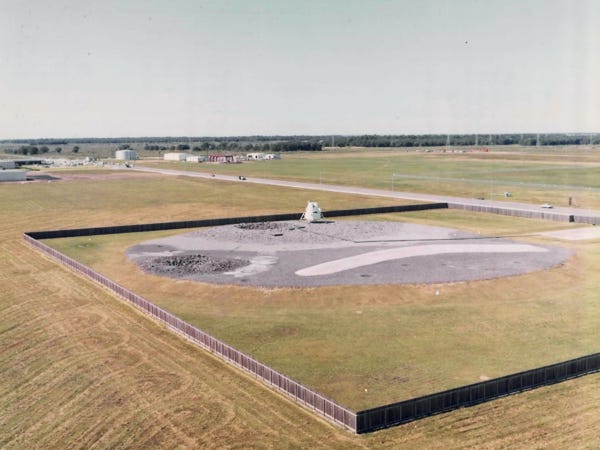
Pulling back from the location of the previous photo, some of the buildings of the main campus can be seen.
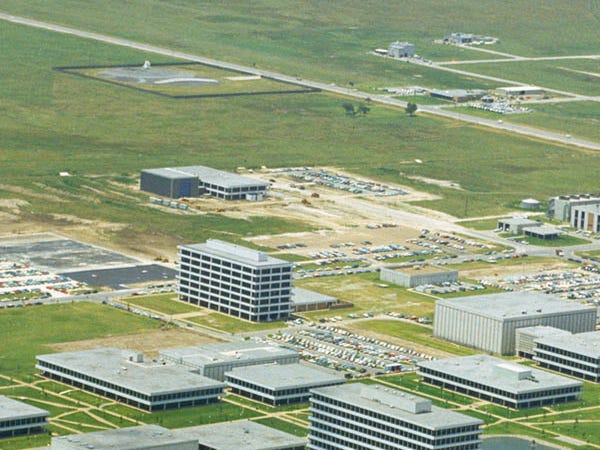
Here is an aerial view of the entire Manned Spacecraft Center as it appeared in 1966 with the Lunar Topographical Simulation Area circled.
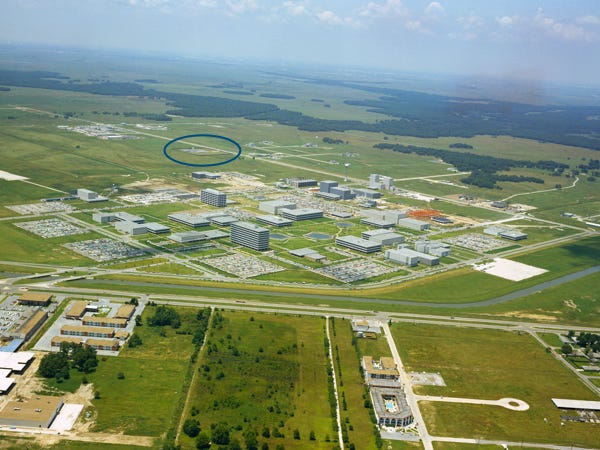
Tranquilly based upon this simulated lunar landscape, adjacent to one of the craters, was a gleaming white full-scale mockup of the LEM as it appeared on configuration drawings at Grumman around 1965. One might easily imagine the surprise and disbelief of some of the locals who happened to drive by the day after the aliens landed!
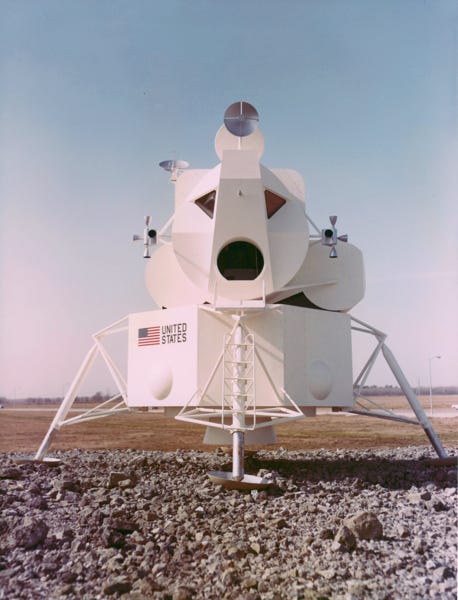
This version of the LEM, by the way, was similar to the low-fidelity one displayed at the Space Park at the 1964-65 New York World’s Fair. Notable updates to the newer 1965 configuration include changes to the landing leg struts, the elimination of the forward facing docking tunnel, addition of the front porch and ladder, and more realistic reaction control nozzles.
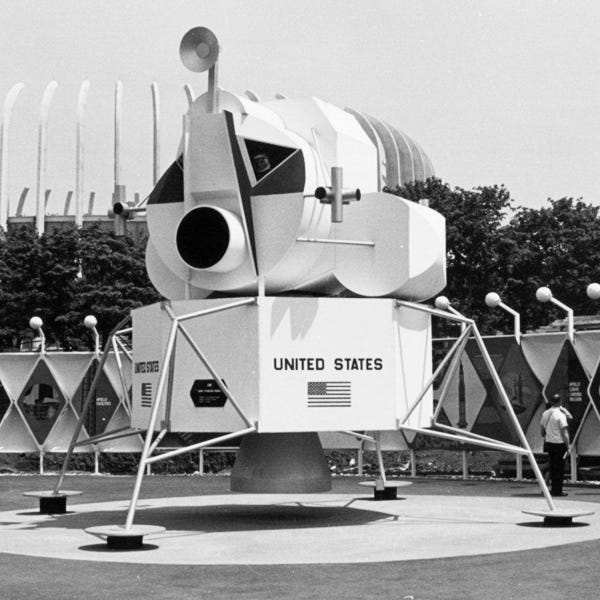
The mockup at the Lunar Topographical Simulation Area has its own claim to fame, beyond being used for astronaut training. World renown illustrator, Norman Rockwell, was commissioned by NASA to paint a depiction of the moment that an Apollo astronaut would take mankind’s first footstep on the Moon.
For his painting, called “Man's First Step on the Moon”, Rockwell visited the Manned Spacecraft Center to get a first-hand look at the best reference material he had access to – the diorama-like simulated Apollo landing site.
Here is Rockwell speaking via a headset to whom I believe to be Jack Mays2, test subject from NASA’s Crew Systems Division. Rockwell was known for his realistic depictions of people experiencing various aspects of life in America. It was typical for him to use posed photographs of people for reference. The lunar landing scene was no different. Rockwell took photographs of Mays in various positions in and around the LEM mockup for use back in his Massachusetts studio.
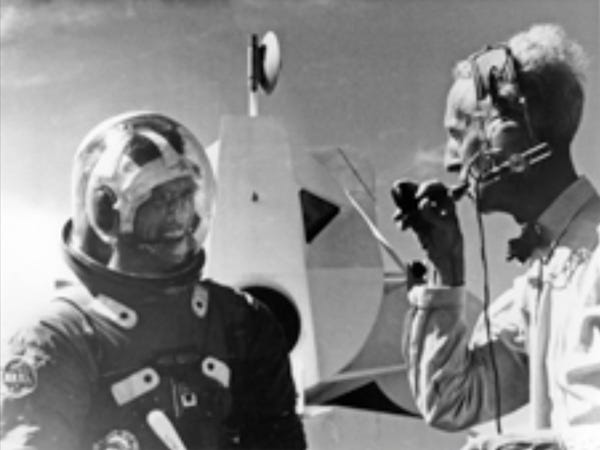
Rockwell’s painting, seen here, was published in the January 10, 1967 issue of Look magazine. More on that in a future post.
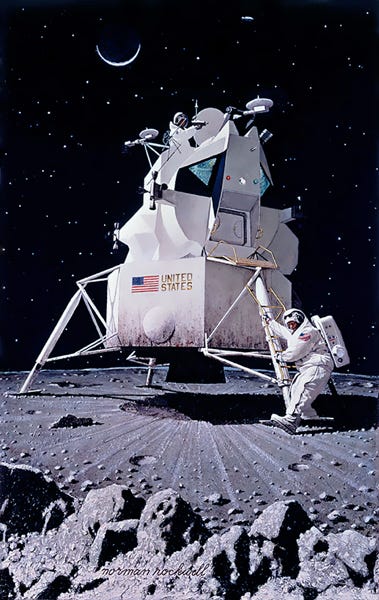
Attack of the 5-Foot Moon Lander – Now in 3-D!
Now that you know about NASA’s lunar rock garden, you have the context for what you are about to see next ... in stunning 3-D!
This is the quarter-scale LEM model, mentioned previously, sitting among the rocks in the Lunar Topographical Simulation Area. The 3-D image is from the June/July 1967 issue of Venture magazine.
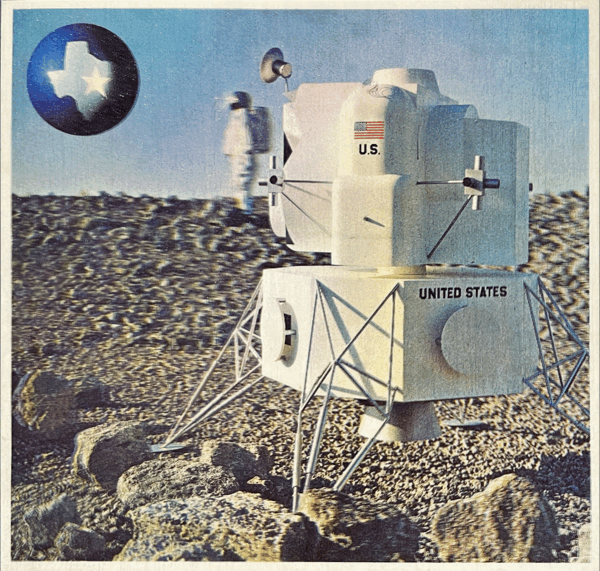
Affixed to the cover of the magazine is a 6.5 inch (16.5 cm) wide by 6.25 inch (15.9 cm) tall 3-D lenticular image of the Apollo Lunar Module model resting on a rocky surface with an astronaut in the background. The photo was taken at the NASA Manned Spacecraft Center, Houston, Texas. The only thing missing that might complete the illusion is a black sky, rather that the bright sunny cloudless day in Texas.
The magazine provides the following caption:
“At the NASA Manned Spacecraft Center, Houston, Texas, a simulated lunar landscape (the rocks come from as far away as Hawaii) permits engineers to test and evaluate the flexibility of astronaut clothing. Venture’s 3-D camera, anticipating 1970, recently put a quarter-scale lunar module and a cooperative dummy on the cratered terrain to suggest the momentous landing – as well as a Texan’s view of the earth from the moon. Photographed by Visual Panographs, Inc.”
Venture was a travel magazine published by Cowles Communications, Inc., the original publishers of LOOK magazine. In the mid-1960s, they pioneered the mass production and publication of 3-D lenticular photographs. Referred to as ‘xographs®’ at the time, they permitted simulated three-dimensional viewing with the naked eyes without special viewers. They achieved this by overlaying a grooved plastic sheet adhered on top of a special banded photograph. The grooves had curved lens-like cross-sections that presented each of the viewer’s eyes with different angles of the image. The result used the properties of parallax vision to create a three-dimensional illusion of depth.
This message to readers from the June 1965 issue of Venture may provide some insight into how novel and revolutionary the mass production of lenticular images was:
Publisher’s Log. If you are startled by the cover of this anniversary issue, you have good reason to be: It is the first three-dimensionally produced cover ever to appear on a national magazine.
This revolutionary departure in photography is called XOGRAPH. The process has been under development by Cowles Magazines and Broadcasting, Inc., VENTURE’s publisher, for more than fourteen years and has been perfected only in the past year. Starting with this issue, XOGRAPH 3-D photography will be featured on the cover of every issue of VENTURE.
The possibilities of three-dimensional photography are enormous, from bringing to life the designs of brilliant artists, such as Marilyn Bass’ paper sculpture of San Francisco on our cover, to re-creating with striking vividness the maiden flight of a new jet. Already our 3-D cameras are roaming the world for subjects. The pictures they take will enable you to step the rim of the Grand Canyon and experience the full impact of its awesome size and depth; to savor the classic proportions of the Acropolis; to sense the very presence of a sheikh standing at a Moroccan roadside.
For almost a century, photographers have understood the principles of three-dimensional photography that could be enjoyed without special glasses.
However, the major problem has been to refine these techniques and adapt them to modern high-speed printing presses. Working with Eastman Chemical Products, Inc., we have hurdled this final barrier.
In addition to the achievement of 3-D printing itself, there was a further challenge in bringing it to VENTURE: It was necessary to develop a new format for our covers, in order to produce the most efficient and accurate application of each 3-D photograph. The result of our efforts is the distinctive new portfolio style cover of this issue.
VENTURE’s aim from its inception has been to involve the reader more personally as a participant in the essential travel experience. We believe that 3-D photography on our covers, and later on inside pages as well, will dramatically enhance the excitement of the world of travel that is VENTURE.
Lenticular images became very popular at that time because of their novelty. They were offered as postcards, trading cards, and were even attached to breakfast cereal boxes. Older specimens are sought after by collectors, and you can find modern examples in stores even today.
I have a collection of spaceflight themed lenticular postcards which I will share in a future post.
Merch of the Month
Rocket Martini Acrylic Block
Celebrate the new year with this festive rocket martini custom acrylic block print.
As a special thank-you for reading Creating Space, I am offering a discount on my artwork. Simply use code CREATINGSPACE15% for 15% off your entire order from the Pixel Planet Pictures shop.
My space-inspired art portfolio can be found at pixel-planet-pictures.com. You can also follow me on Instagram (pixelplanetpics).
Do you know fellow Space Geeks who might enjoy Creating Space? Invite them into this space, too!
Did you miss a post? Catch up here.
If you enjoyed this article please hit the ‘Like’ button and feel free to comment.
All images and text copyright © Dave Ginsberg, unless otherwise noted. All rights reserved.
If you do decide to go on your own trip to the simulated Moonbase, be advised that some digging may be required. If you are lucky, you may find a rock or two. But, watch out for the Lunar Guard Squad. My guess is that NASA may frown upon unauthorized sample return missions.
Modern day maps and photographs show very little remaining evidence of the Lunar Topographical Simulation Area. These present day aerial views from Google Maps reveal the area as a slightly greener parcel of grass in the shape of the formerly fenced-in area. You can see what may be a vestigial stub of the entrance driveway off of West Linkage Road, and a brown patch to its south that roughly equates to the size and shape of what might have been the original parking area. One might even be convinced that the outline of the larger of the two craters and what was once the raised rock mound can still be seen as a lighter brown patch on the west side.
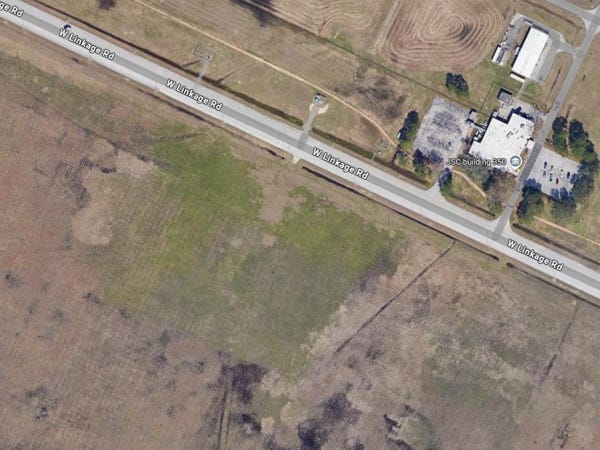
Compare the following image with the one at the top of this section.
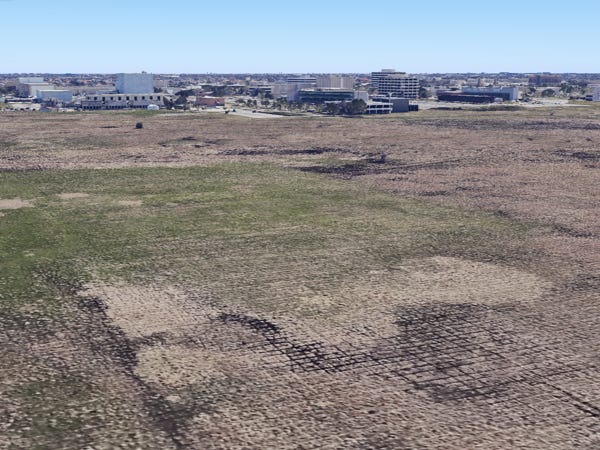
NASA via Mike Acs’ Flickr, a_v_c_v_AKP (S-66-45462), front, back
"LUNAR TESTS -- Jack Mays, a test subject from the MSC Crew Systems Division, wears an International Latex Corporation spacesuit under a thermal overgarment during tests at the Lunar Topographical Simulation Area. He is also wearing a Portable Life Support System (PLSS) back pack. A full-scale mock-up of a Lunar Module is in background."
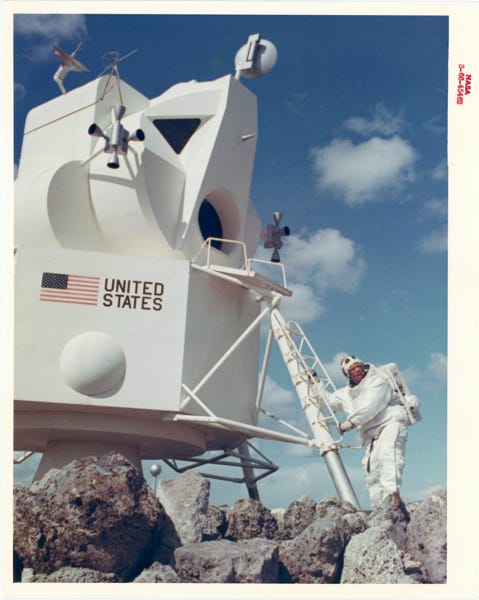


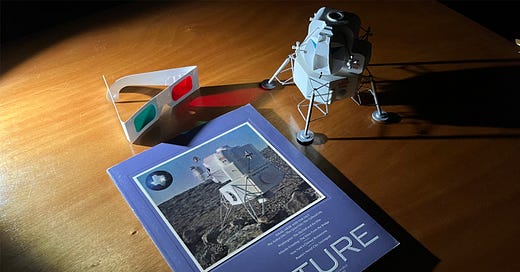


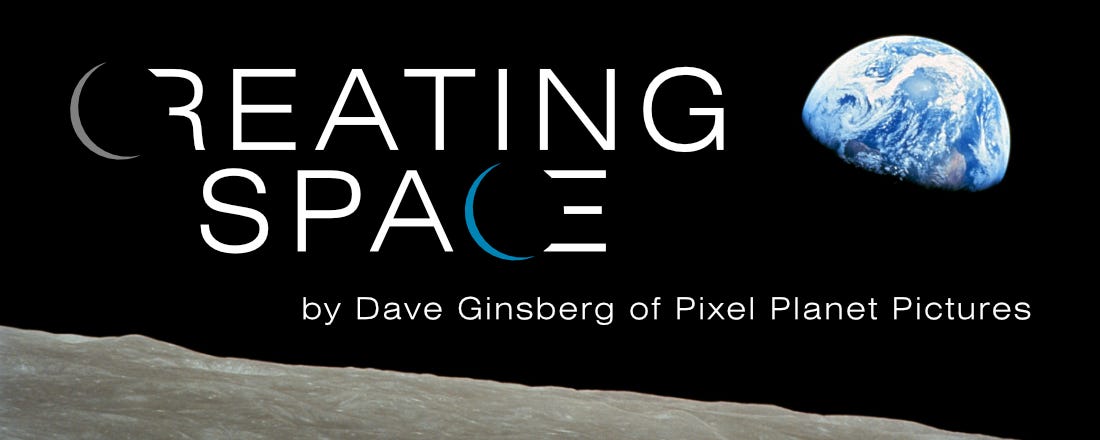
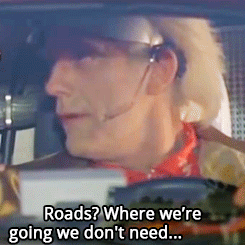
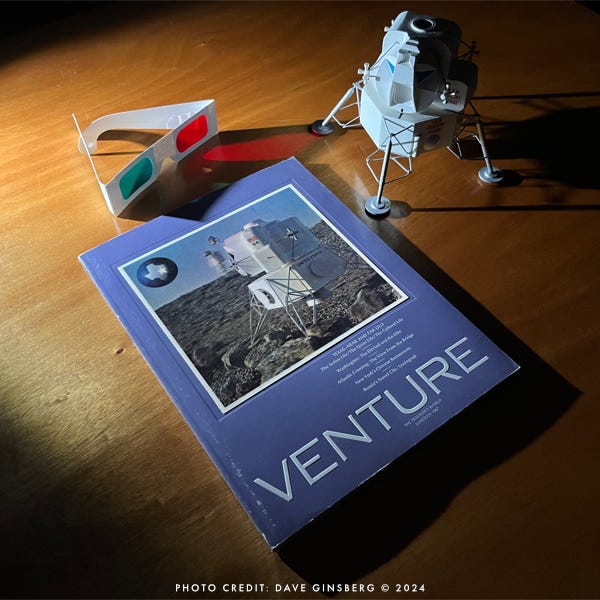
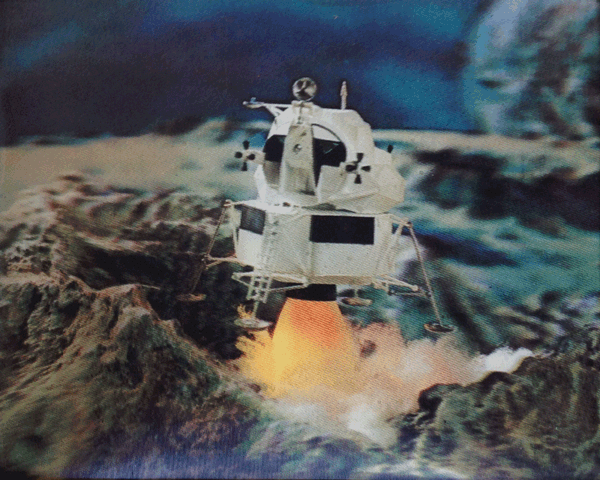

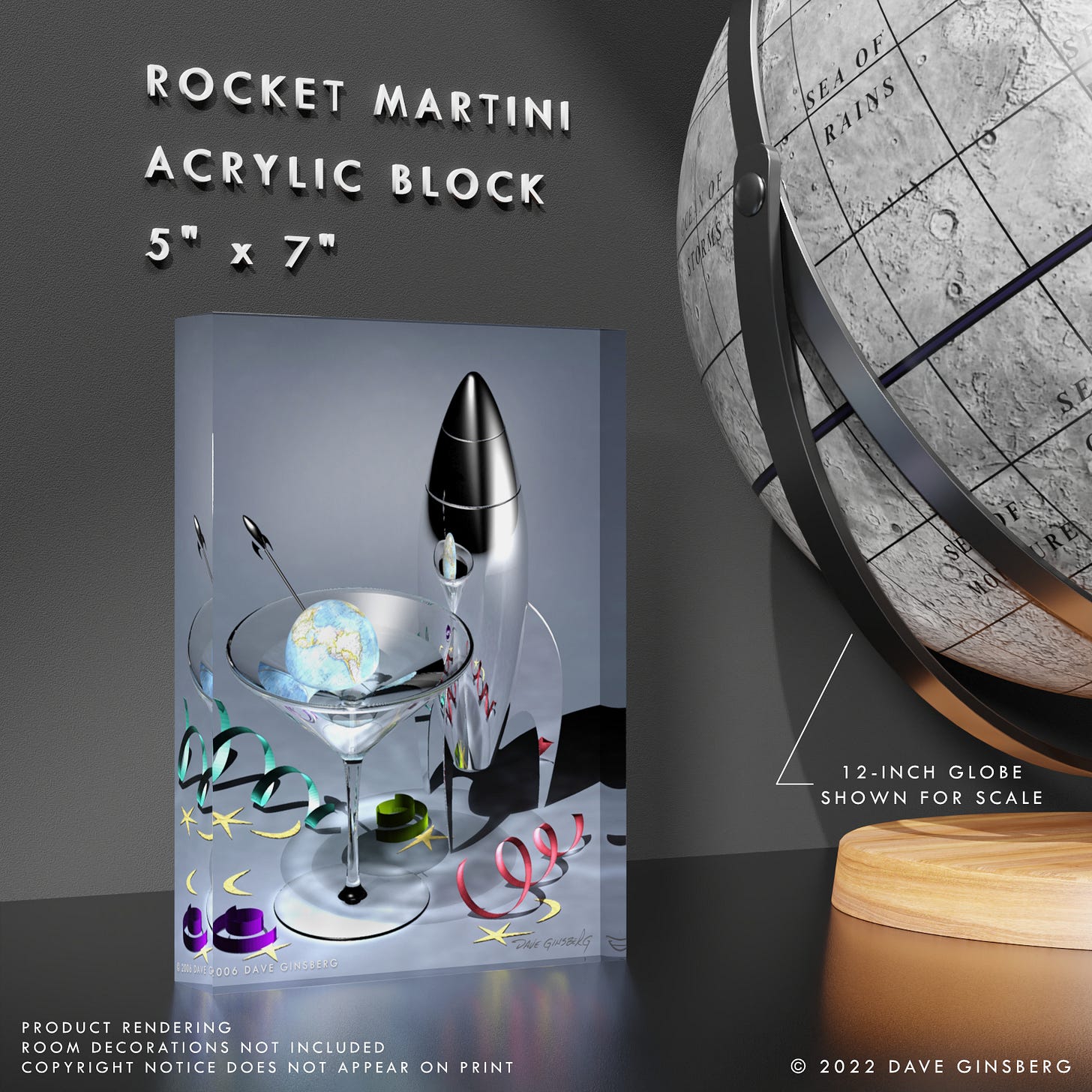




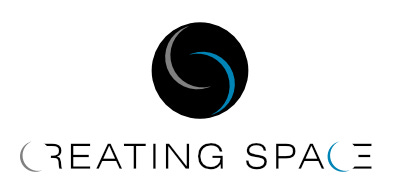
Oh the memories of those days and the cards! I can't recall all the cards I had but I do remember the APOLLO spacecraft reentry card with the ablation effects included! Those were exciting times of exploration! GO NASA!! I don't recall the LEM cards so it was nice to see those that you posted.
I've not seen lenticular 3d turned into animations before, nice one!